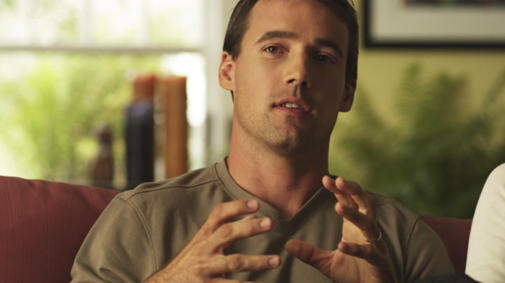Note: Over the next few weeks, we’ll be reading through the Viewer’s Guide for the video “Made for Each Other.” In the video, married couple Josh and Carrie reflect on the meaning of sexual difference. Each section of the Viewer’s Guide takes a quote from either Josh or Carrie and fleshes it out. The goal of the Viewer’s Guide is to help you, the reader, become more confident in promoting and defending the meaning of marriage as the union of one man and one woman.
In part 5, we’ll see why sexual difference is more than anatomy, and we we’ll talk about the spousal meaning of the body and the role of science.
“It’s not just about biology…”
Returning to sexual difference, Josh makes an important point. The difference between a man and a woman is not just an insignificant biological fact. [i] “We’re wired differently,” as Josh says. Biology is important, but the body and the person are not reducible to biology. Sexual difference involves the whole person, body and soul.
Furthermore, as Pope John Paul II taught, the body has a “spousal meaning.” [ii] The body, in its masculinity or femininity, reveals that we are persons who are made to be a gift to others and to be received as a gift by others. This spousal meaning of the body speaks an essential truth relevant to all people, not only those called to marriage. It also indicates what was said above, that the body is more than just a biological reality. The body reveals the person. We’re not souls trapped in bodies. We’re “body-persons.” We don’t just have a body. We are our bodies in a real sense. Our bodies are fundamental to who we are. The body of a man and the body of a woman are distinct, personal realities.
A husband and a wife have unique and personal gifts that they offer to each other. Not only do they give each other their physical bodies, but they give their distinct persons to each other, as man and woman, in and through their bodies, in and through their sexual difference. Their bodies speak a unique language of love, reserved specifically for marriage. Neither biology nor culture alone can explain this. It has to do with the nature of the human person as a unity of body and soul, created as man and woman. [iii]
That being said, it is a curious phenomenon of our time that, while the natural sciences have advanced in so many areas, including in the study of the human person, an appreciation and application of these sciences in relation to sexual difference and human sexuality in general is often lacking in our contemporary society. Why is this? It’s a worthy question to consider. For example, when it comes to food and diet these days, we do not hear things like “eat whatever and however much you want because there won’t be any consequences (or we’ll handle the consequences as they come).” Medically and scientifically speaking, no one buys that.
But what about the body and sex? Our culture’s prevailing philosophy seems to deny that there are powerful consequences to sex. Even when faced with the facts of such consequences, the dominant philosophy continues to say “do whatever you want with your body and we’ll deal with the consequences as they come—in fact, we’ll do whatever it takes to let you do anything to your body…” Sounds like a disconnect here and a lack of medical and scientific rigor. And what about sexual difference? While some play down the reality of sexual difference or limit it to the difference between female and male anatomy, sciences such as neurobiology, gynecology, evolutionary psychology, endocrinology, histology, and reproductive physiology—to name a few—point to the intricate, unique and complementary physiologies of women and men. Sexual difference is more than a surface difference in human anatomy, and attempts to explain sexual difference as a socially constructed reality are lacking in rigor. The body/person dualism of today (i.e., which holds that the body is separable from the person and that we can therefore do whatever we want to with our bodies) is neither realistic nor scientific. All of this is to say that while sexual difference is more than a biological fact, biology and the related sciences can be of great help in appreciating the unique gifts of men and women.
Previous sections:


It occurs to me that the apostle seemed to think that the preferred marital status was none at all, those who remain celibate are closest to God, but he tolerated marriage as a way of controlling the passions. In scripture it seems quite difficult to find a clear definition, in fact in many old testament stories many non-traditional marriages are tolerated. If we as Catholics are going to insist on a definition of marriage as between man and woman I think we really ought to find a better justification for it than this. Without scriptural justification for this stance, and without a basis in humanistic thinking our defense of marriage as strictly heterosexual l
Justin, thanks for your comment. You raise some important issues. I’ll try to address them all in turn – it merits a long response!
1. St. Paul on marriage and celibacy
You write that the apostle (I presume you mean St. Paul?) “seemed to think that the preferred marital status was none at all, those who remain celibate are closest to God, but he tolerated marriage as a way of controlling the passions.” I imagine you’re thinking of Scripture passages such as 1 Corinthians 7:8-9 “Now to the unmarried and to widows, I say: It is a good thing for them to remain as they are, as I do, but if they cannot exercise self-control they should marry, for it is better to marry than to be on fire” or 1 Corinthians 7:38 “So then, the one who marries his virgin does well; the one who does not marry her will do better.” (NAB translation)
Here are some considerations for understanding St. Paul’s teaching on marriage:
a. We must be attentive to the unity of all Scripture when interpreting any particular passage (see the Catechism of the Catholic Church [CCC], 112). In this case, it’s important to read St. Paul’s words in 1 Corinthians 7 in light of his teaching on marriage in Ephesians 5 (and vice versa). St. Paul’s words here, speaking of marriage “in reference to Christ and the Church” (5:32), has long been interpreted as an affirmation of marriage’s place in the sacramental life of the Church (see CCC, 1612-1617). Thus St. Paul himself recognized the beauty of marriage in its sacramental imaging of Christ’s love for his Church, so we would be wrong to interpret his words in 1 Cor 7 as in any way denigrating marriage.
b. At the same time, as you imply in your comment, St. Paul’s teaching in 1 Cor 7 is instrumental to help us understand what the Church means when she says that the consecrated (or virginal) state of life “has objective superiority” over the married state of life (see Bl. John Paul II, Vita Consecrata, 36; CCC, 916). This “objective superiority” comes from the fact that the consecrated life “mirrors Christ’s own way of life” and “proclaims and in a certain way anticipates the future age” (VC, 36). This does not mean that any particular consecrated person is holier or closer to God than any particular married person. It also does not mean that every person has the obligation to enter the consecrated state. These would be misinterpretations of the Church’s teaching and of St. Paul himself, who says earlier in 1 Cor 7 that “each [person] has a particular gift from God, one of one kind and one of another” (v. 7), meaning that the state that is subjectively superior for each particular person is that state to which the Lord calls him or her.
c. Bl. John Paul II treats St. Paul’s teaching in 1 Cor 7 at length in his teachings on the theology of the body, and I encourage you to study them. See TOB 82-25.
2. In scripture it seems quite difficult to find a clear definition, in fact in many old testament stories many non-traditional marriages are tolerated
If I could rephrase your question, you seem to be asking, “What does Scripture teach us about marriage? There are so many conflicting types of marriage in the Bible, especially in the Old Testament.”
One place to start is to remember that Scripture must be read and interpreted within the living Tradition of the Church (CCC 113). The Church is guided by the same Spirit who inspired the Scriptures (CCC 111; Dei Verbum 12). The teaching of the Church, based on the witness of Scripture and the living Tradition of the Church, is that marriage is the lifelong union of one man and one woman. It is a vocation “written in the very nature of man and woman” (CCC 1603) and, when both husband and wife are baptized, marriage is a sacrament, a sign of Christ’s love for His Church (CCC 1638-1642).
Where does the Church get this from? From the teaching of Christ himself. I refer you to Christ’s words to the Pharisees in Matthew 19, when he directs their attention “back to the beginning,” to creation, in order to understand the meaning of marriage. (Also see Pope John Paul’s reflection on this passage in TOB 1-23). The Church also draws heavily on St. Paul’s teaching in Ephesians 5. But remember that because Scripture is part of the Church’s living tradition, meaning that the Church, guided by the Spirit, enters into ever greater understanding of God’s self-revelation in Scripture (see DV, 8), the Catholic faith is not one of “proof-texts” but of the Word, Scripture and Tradition together.
About the Old Testament: yes, there are instances of many “kinds” of marriage in the Old Testament, for example, polygamy. But the fact of their presence in Scripture – or even that they were “tolerated” – does not mean that they are held up by the Scriptural authors as the ideals of marriage. Even in the Old Testament itself, the prophets consistently used the model of monogamous marriage as an image of God’s love for his people, a direct rebuke to the practice of polygamy. And we saw how in Matthew 19, Jesus is presented with a kind of Old Testament marriage, namely one that allowed the husband to send his wife away with a bill of divorce. Jesus does not sanction this simply because it was the practice of the people; no, he goes “back to the beginning,” to the Creator’s intent for marriage.
There is indeed ample Scriptural justification for the Church’s teaching on marriage, particularly her teaching on the need for a man and a woman. I encourage you to read extensively in John Paul IIs “theology of the body,” which is largely an exegesis of Scripture, and also to read the Second Vatican Council’s teaching on Scripture and its interpretation, Dei Verbum.
God bless you.
Absolutely, marriage is beautiful. Much more than biology alone and yet it includes it in a magical way, one that brings new life to this world. One man, one woman and God.